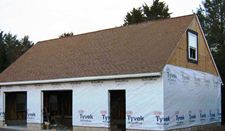Over the past three decades, house wrap has become a staple feature on millions of buildings. Wrapping a wood framed building in a protective envelope is a good building practice which helps combat a building’s worst enemies: water, moisture and air infiltration. House wrap behind a building’s siding is an excellent secondary defense against the weather.
House wrap is a weatherization membrane which provides a protective layer under a building’s siding and over the wall girts or sheathing. It is literally wrapped around a building, cut out around windows and doors and taped at the seams.
The unique, nonwoven-fiber structure of house wrap resists air infiltration and water intrusion, yet is engineered to readily allow moisture vapor to diffuse through the sheet, helping prevent mold and mildew buildup and wood rot. The fibrous structure is engineered with microscopic pores which readily allow moisture vapor to evaporate but are so small bulk water and air cannot penetrate. Siding, whether vinyl, wood, stucco, brick, or composite, does not completely prevent air and water penetration. House wrap is designed as a secondary defense to help manage a building’s wall systems.
 R-Value ratings for insulation are only maintained as long as the air within the insulation stays still and dry. The Department of Energy estimates nearly 40% of a building’s energy loss is the result of air infiltration caused by wind driven pressures from the outside. The opposing forces of pressure between inside and outside walls cause heat and air conditioning to be virtually sucked from a building– through walls, ceilings, sill plates, sheathing joints, top plates, electrical outlets and every inch of the estimated half-mile of cracks in newly constructed buildings. As air infiltrates, it causes changes in temperature which require heaters or air conditioners to work harder. Constant temperature fluctuations also reduce comfort levels. Occupants feel too cold or too warm. Reducing air infiltration increases a building’s comfort factor.
R-Value ratings for insulation are only maintained as long as the air within the insulation stays still and dry. The Department of Energy estimates nearly 40% of a building’s energy loss is the result of air infiltration caused by wind driven pressures from the outside. The opposing forces of pressure between inside and outside walls cause heat and air conditioning to be virtually sucked from a building– through walls, ceilings, sill plates, sheathing joints, top plates, electrical outlets and every inch of the estimated half-mile of cracks in newly constructed buildings. As air infiltrates, it causes changes in temperature which require heaters or air conditioners to work harder. Constant temperature fluctuations also reduce comfort levels. Occupants feel too cold or too warm. Reducing air infiltration increases a building’s comfort factor.
Insulation can help increase the R-value, but it is only marginally effective in reducing air infiltration. When air infiltrates, the R-value itself can be reduced up to 60%. Adding thicker insulation won’t solve the problem. Stopping air from getting in, will.
Properly applied, house wrap helps reduce air infiltration, preserving R-values, conserving energy, reducing heating costs and creating a more comfortable interior.
The tighter the building, the more comfortable and efficient. Unfortunately, the tighter a home, the more susceptible to moisture problems which can cause mold, mildew and rot. So all systems need to be in balance–designed to manage water and moisture effectively.
There are two main ways water and moisture get into wall systems:
Bulk water intrusion from the exterior (rain and snow) can enter the wall and, if not allowed to dry in a reasonable amount of time, can raise the moisture content of the wood above 30% and cause rotting or mold and mildew.
Air transported moisture occurs when air leaks from the warm side of the wall to the cool side. Warm air will hold higher amounts of moisture than cold air. As warm air travels through a wall heading to the cold side, it will begin to cool and be forced to release moisture. This is called the dew point where condensation will occur. When there is a significant temperature drop across the wall, the dew point will occur somewhere within the wall. In the winter months the point of condensation is usually on the inside surface of the exterior sheathing. Moisture carried by air flow through the wall is deposited at the back side of the sheathing and accumulates. In hot and humid climates where air flow is traveling from the outside to the inside, warm moist air from the outside will be cooled on the way to the air conditioned inside, releasing moisture within the wall cavity. House wrap is a breathable membrane with microscopic pores which allow the moisture vapor to dissipate, helping to dry out a wall system to avoid damage.
Moisture Vapor Transmission Rate or perm rate of a material determines the ability for water vapor to diffuse or evaporate through the wall. The higher the perm rate, the more “breathable” the material is and the easier it is for water vapor to pass through. Materials with Perms below 1 are considered vapor retarders since the rate of moisture vapor flow through a 1 Perm material is so low there is essentially no flow. House wraps have Perm rates in the area of at least 58 Perms which is very open to allow moisture vapor to flow through.
What house wrap is not, is a vapor barrier or an insulation. I’ve seen instances where people have applied house wrap directly between roof purlins and roof steel, in an effort to control condensation. House wrap is quite permeable; any warm moist air which would rise to it will pass through to the underside of the roof steel and condense.
House wrap is great…if used for what it was intended for…a secondary defense against the weather.






